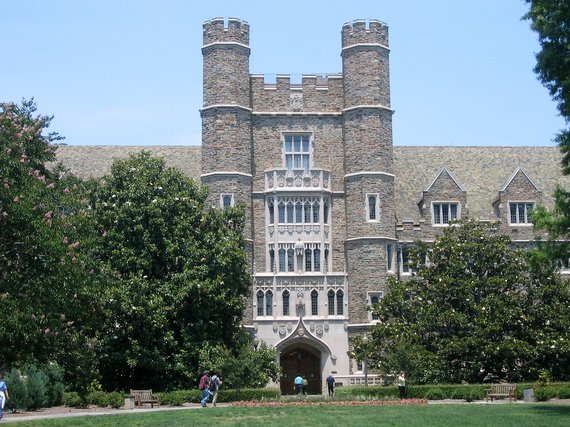Thinking about taking your high school junior on a college tour this spring? The timing is usually ideal, with students starting to engage more seriously in the college discussion and ready to get a firsthand look at promising schools. And many colleges are in session, which allows for a more vibrant and real-life look at these schools than summer timing would.
To get the most out of a longer trip where you'll be visiting several schools, it's key to do some planning. While I write about this topic at greater length in my book, Finding the Right Colleges for You: 7 Steps to Researching & Evaluating Schools That Match Your Needs, here are my best tips for a successful -- and enjoyable -- spring college tour:
1. Include your teen in the planning. While you may need to take the lead on the logistics, teens should have an active role in the discussions. You will want them to own the college application process, so set the tone now by engaging them in the planning. And when you're on campus, let the teens be in charge. The students, yours and others, should ask their questions first, then go ahead and ask yours -- but limit your questions to those particularly relevant to your role, such as safety concerns and financial aid.
2. Focus on one geographic area. Discuss with teens their colleges of interest and choose one area of the country where a group of these schools are clustered. Prioritize their favorite colleges but make sure to include schools where they have a good likelihood of admission. If these will be your student's first college visits, you'll want to plan on visiting schools that vary in other differentiating criteria as well, such as size and location, to get a well-rounded picture of options. When mapping out your route, don't forget to check college calendars so you can ideally visit while schools are in session.
3. Plan to visit one, no more than two, campuses per day. These visits can be exhausting, both physically and emotionally, so pace yourselves. Build in down time between schools by checking out a local attraction, trying a fun restaurant, or just hanging out in your hotel room. This is doubly important if younger siblings are in tow. Make sure to take daily breathers from "college talk," when you can purposefully steer the conversation to less charged topics. When planning your visits, you'll also need to be realistic about travel times: For example, if you're driving, plan for bathroom stops and unexpected traffic delays. And build in time to find parking and get to the right campus location so you're not rushing and stressed about being late.
4. Make the most of the student-led campus tour. The typical introductory college visit includes an information session hosted by the college admissions office, followed by a student-led campus tour. Sign up for these as soon as you firm up your itinerary because they often fill up during the busy spring months. If visiting teens can choose their guide for the campus tour, let them find one with academic or other interests they share (the guides will typically introduce themselves briefly and tell you where they're from, what they're studying, and how they are involved on campus). And parents, offer to go with a different tour guide if your student prefers that (which allows you to get a different perspective and ask questions without embarrassing your teen!). Encourage your student to stay close to the tour guide so they can take advantage of breaks in the presentation (often while walking between stops) to engage the tour leader and ask questions. Teens may wish to ask for the guide's contact information at the end of the tour so they can follow up with a thank you email and further questions. And make sure you all dress comfortably as you'll be doing a lot of walking (check the forecast so you're prepared for inclement weather too).
5. Build in time to wander the campus. Going beyond the school-sanctioned tour stops can be illuminating; you'll learn a lot by observing students and college staff working and relaxing. Spend time in the student center, coffee shop, quad, or other gathering areas. Engage undergraduates in conversation and do a little eavesdropping. Are they talking about classes, current events, parties? Is what they are saying echoing the angle the admissions staff presented in the information session? Look at notice boards around campus. What is being advertised? What are upcoming events on campus? Pick up a copy of the student newspaper and other campus publications. Politics, social action, athletics: What is taking center page? What is being discussed and debated? Find a central spot on campus and open a map, then see how long it takes for a student to offer to help you find your way. Engage students by asking for directions. How helpful and friendly are they? Make sure to meet up with any students you know who attend the school -- and ask to see their dorm rooms, as most tours will not include this.
6. Notice your surroundings. How well are the grounds and buildings maintained? Does the campus seem like a good size for you? How are the students dressed? Are there popular name brands they all seem to wear? What do their t-shirts say? How prevalent are tattoos and piercings? Do students follow the latest fads? How much school spirit do you observe? Do many students sport the college name on their sweats and accessories? How diverse are students and faculty? Are students rushing by or are they hanging out? Do students look happy? What books, magazines, and newspapers are students carrying or reading? How safe does the campus seem? Do you notice lights, emergency phones, security personnel? Are doors to dorms locked or can you walk right in? How safe does the area surrounding campus seem?
7. Spend time alone. If possible, build in time for teens to take a break from parents and others; let them walk around on their own or sit in a busy part of the campus and watch the college students and faculty. Encourage them to ask themselves: How do I feel? Could I see myself here? Can I be myself here? Do I fit in academically, intellectually, socially? Could I make good friends here? Would I want to be friends with the students I met and observed? Are there enough students who share my priorities and concerns, but enough diversity for me to stretch my worldview? Do I feel comfortable with the way students dress and wear their hair? Would I fit in? This might be a good time for your student to jot down notes about their impressions and feelings so they stay fresh in their minds.
8. Take time to process what you've learned. Know your teens and respect their needs. Some may want to discuss each visit by sharing their impressions immediately. Others may need time and space to absorb everything they've seen and heard. Either way, let them initiate the conversation. And encourage them to jot down some notes after the visit -- likes, dislikes, feelings, questions -- because schools may start blending together after a few days. Understand teens may be anxious and need your support during these visits. Don't over-react to irrational statements they may make ("I can't go here because I hated the tour guide!"). Your role is to listen rather than talk, to ask questions rather than give opinions.
Keep in mind, this is only the beginning of a year-long college application process; it's also likely to be one of the remaining few chances to spend quality time with your teenagers before they leave the nest. So if there's any way to make this college tour both a productive and enjoyable experience, you'll be thankful for the opportunity. Happy touring!
This article was summarized from a chapter of my new e-book, Finding the Right Colleges for You: 7 Steps to Researching & Evaluating Schools That Match Your Needs.

